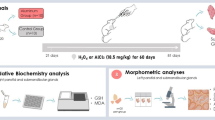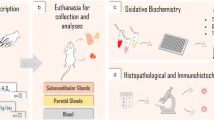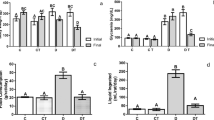Abstract
Our study was designed to clarify the role of antioxidant enzymes in the rat von Ebner gland during acute nickel toxicity. After treatment with nickel acetate, we monitored ultrastructural alterations in acinar and ductal cells, immunohistochemical staining for glutathione peroxidase (GPx) and glutathione S-transferases (GST mu and GST pi), and immunoreactivity for malondialdehyde (MDA). Immunoreactivity for MDA was present only in the acinar cells, and it was enhanced at 3 h after Ni treatment. In contrast, immunoreactivities for GPx and GSTs did not change in acinar cells but significantly increased in ductal cells after Ni treatment. Cytoplasmic vacuoles increased in acinar cells at 3 h after Ni treatment, but they almost completely disappeared at 24 h. No morphological changes were observed in taste bud cells from Ni-treated rats. Because lipid peroxidation, as monitored by immunoreactivity for MDA, was only transiently increased in the acinar cells, the enhanced antioxidant enzyme immunoreactivity in ductal cells of the von Ebner gland plays a crucial role in the self-defense system against nickel toxicity in the rat oral cavity.
Similar content being viewed by others
References
Aitio A (1984) Biological monitoring of occupational exposure to nickel. In: Sunderman FW Jr (ed) Nickel in the human environment: proceedings of a joint symposium, March 1983, Lyon, France. IARC scientific publication no. 53. International Agency for Research on Cancer, Lyon, France, pp 497–505
Grandjean P (1984) Human exposure to nickel. In: Sunderman FW Jr (ed) Nickel in the human environment: proceedings of a joint symposium, March 1983, Lyon, France. IARC scientific publication no. 53. International Agency for Research on Cancer, Lyon, France, pp 469–480
Block GT, Yeung M (1982) Asthma induced by nickel. JAMA 247:1600–1602
Davies JE (1986) Occupational asthma caused by nickel salts. J Soc Occup Med 36:29–31
Costa M, Mollenhauer HH (1980) Phagocytosis of nickel subsul-fide particles during the early stages of neoplastic transformation in tissue culture. Cancer Res 40:2688–2693
Costa M, Heck JD (1984) Perspectives on the mechanism of nickel carcinogenesis. Adv Inorg Biochem 6:285–309
Oller AR, Costa M, Oberdrster G (1997) Carcinogenicity assessment of selected nickel compounds. Toxicol Appl Pharmacol 1143:152–166
Emmett EA, Risby TH, Jiang L, Ng SK, Feinman S (1988) Allergic contact dermatitis to nickel: bioavailability from consumer products and provocation threshold. J Am Acad Dermatol 19:314–322
Estlander T, Kanerva L, Tupasela O, Keskinen H, Jolanki R (1993) Immediate and delayed allergy to nickel with contact urticaria, rhinitis, asthma and contact dermatitis. Clin Exp Allergy 23: 306–310
Henkin RI, Brandley DF (1970) Hypogeusia corrected by Ni++ and Zn++. Life Sci II 9:701–709
Järup L (2003) Hazards of heavy metal contamination. Br Med Bull 68:167–182
Sunderman FW (1989) Mechanisms of nickel carcinogenesis. Scand J Work Environ Health 15:1–12
Rodriguez RE, Misra M, Kasprzak KS (1990) Effects of nickel on catalase activity in vitro and in vivo. Toxicology 63:45–52
Sirover MA, Loeb LA (1976) Metal activation of DNA synthesis. Biochem Biophys Res Commun 70:812–817
Patierno SR, Costa M (1987) Effects of nickel (II) on nuclear protein binding to DNA in intact mammalian cells. Cancer Biochem Biophys 9:113–126
Haugaard N (1968) Cellular mechanism of oxygen toxicity. Physiol Rev 48:311–373
Matès JM, Pèrez-Gòmez C, Nùñez de Castro I (1999) Antioxidant enzymes and human diseases. Clin Biochem 32:595–603
Tanikawa K, Torimura T (2006) Studies on oxidative stress in liver diseases: important future trends in liver research. Med Mol Morphol 39:22–27
Flora SJ (2007) Role of free radicals and antioxidants in health and disease. Cell Mol Biol 53:1–2
Matès JM (2000) Effects of antioxidant enzymes in the molecular control of reactive oxygen species toxicology. Toxicology 153:83–104
Flohè L, Gunzler WA, Schock HH (1973) Glutathione peroxidase: a selenoenzyme. FEBS Lett 32:132–134
Meyer DJ, Beale D, Tan KH, Coles B, Ketterer B (1985) Glutathione transferases in primary rat hepatomas: the isolation of a form with GSH peroxidase activity. FEBS Lett 184:139–143
Ishikawa T, Esterbauer H, Sies H (1986) Role of cardiac glutathione transferase and of the glutathione S-conjugate export system in biotransformation of 4-hydroxynonenal in the heart. J Biol Chem 261:1576–1581
Jakoby WB (1978) The glutathione S-transferase: a group of multifunctional detoxification protein. Adv Enzymol Relat Areas Mol Biol 46:384–414
Salinas AE, Wong MG (1999) Glutathione S-transferase: a review. Curr Med Chem 6:279–309
Mannervik B, Danielson UH (1988) Glutathione transferase: structure and catalytic activity. Crit Rev Biochem 23:283–337
Meyer DJ, Coles B, Pemble SE, Gilmore KS, Fraser GM, Ketterer B (1991) Theta, a new class of glutathione transferases purified from rat and man. Biochem J 274:409–414
Fujimoto S, Murray RG (1970) Fine structure of degeneration and regeneration in denervated rabbit vallate taste buds. Anat Rec 168:393–414
Thaete LG, Crouch RK, Spicer SS (1985) Immunolocalization of copper-zinc superoxide dismutase. J Histochem Cytochem 33: 803–808
Yamamoto H, Sasaki J, Nomura T, Nawa T (1999) Expression of manganese superoxide dismutase in rat submandibular gland demonstrated by in situ hybridization and immunohistochemistry. Ann Anat 181:519–522
Coleman RA, Hanker JS (1978) Catalase in salivary gland striated and excretory duct cells. III. Immunocytochemical demonstration with fluorescein and peroxidase-labelled antibodies. Histochem J 10:377–387
Campbell JAH, Corrigall AV, Guy A, Kirsch RE (1991) Immunohistologic localization of alpha, mu, and pi class glutathione S-transferases in human tissues. Cancer (Phila) 67:1608–1613
Palinski W, Herttula SY, Rosenfeld ME, Butler SW, Socher SA, Parthasathy S, Curtiss LK, Witztum JL (1990) Antisera and monoclonal antibodies specific for epitopes generated during oxidative modification of low density lipoprotein. Arteriosclerosis 10: 325–335
Yamada S, Kumazawa S, Ishii T, Nakayama T, Itakura K, Shibata N, Kobayashi M, Sakai K, Osawa T, Uchida K (2001) Immunochemical detection of a lipofuscin-like fluorophore derived from malondialdehyde and lysine. J Lipid Res 42:1187–1196
Morita M, Kudo H, Doi Y, Hirano T, Ikemura K, Fujimoto S (2002) Enhanced immunocytochemical expression of antioxidant enzymes in rat submandibular gland after normobaric oxygenation. Anat Rec 268:371–380
Muse KE, Oberley TD, Sempf JM, Oberley LW (1994) Immunolocalization of antioxidant enzymes in adult hamster kidney. Histochem J 26:734–753
Nishino T, Kudo H, Doi Y, Maeda M, Hamasaki K, Morita M, Fujimoto S (2001) Immunocytochemistry of glutathione S-transferase in taste bud cells of rat circumvallate and foliate papillae. Chem Senses 26:179–188
Fong KL, McCay PB, Poyer JL (1973) Evidence that peroxidation of lysosomal membranes is initiated by hydroxyl free radicals produced during flavin enzyme acitivity. J Biol Chem 248:7792–7797
Lledìas F, Rangel P, Hansberg W (1998) Oxidation of catalase by singlet oxygen. J Biol Chem 273:10630–10637
Fujita H, Haseyama T, Kayo T, Nozaki J, Wada Y, Ito S, Koizumi A (2001) Increased expression of glutathione S-transferase in renal proximal tubules in the early stages of diabetes: a study of type-2 diabetes in the Akita mouse model. Exp Nephrol 9:380–386
Carlsson J (1987) Salivary peroxidase: an important part of our defense against oxygen toxicity. J Oral Pathol 16:412–416
Kiser C, Caterina J, Engler JA, Rahemtulla B, Rahemtulla F (1996) Cloning and sequence analysis of the human salivary peroxidase-encoding cDNA. Gene (Amst) 173:261–264
Author information
Authors and Affiliations
Corresponding author
Rights and permissions
About this article
Cite this article
Shiraishi, M., Doi, Y., Kayashima, K. et al. Antioxidant enzyme immunoreactivity in rat von Ebner gland after nickel treatment. Med Mol Morphol 41, 44–52 (2008). https://doi.org/10.1007/s00795-007-0386-3
Received:
Accepted:
Published:
Issue Date:
DOI: https://doi.org/10.1007/s00795-007-0386-3




